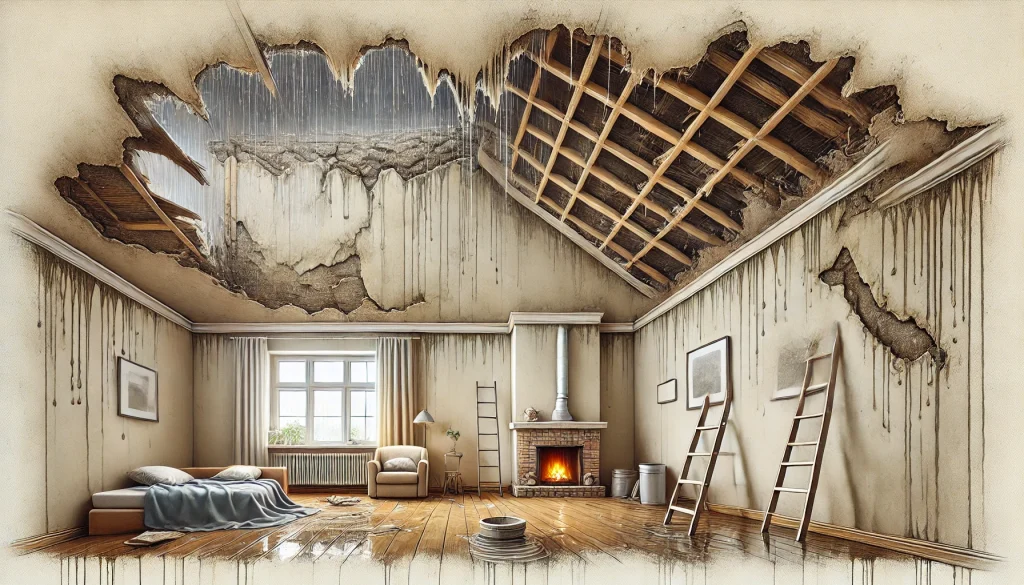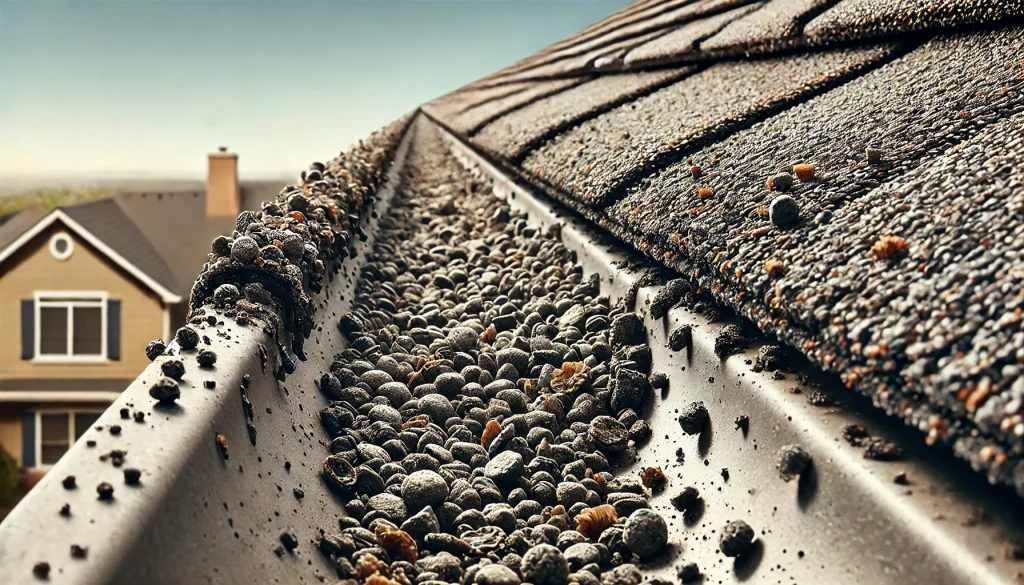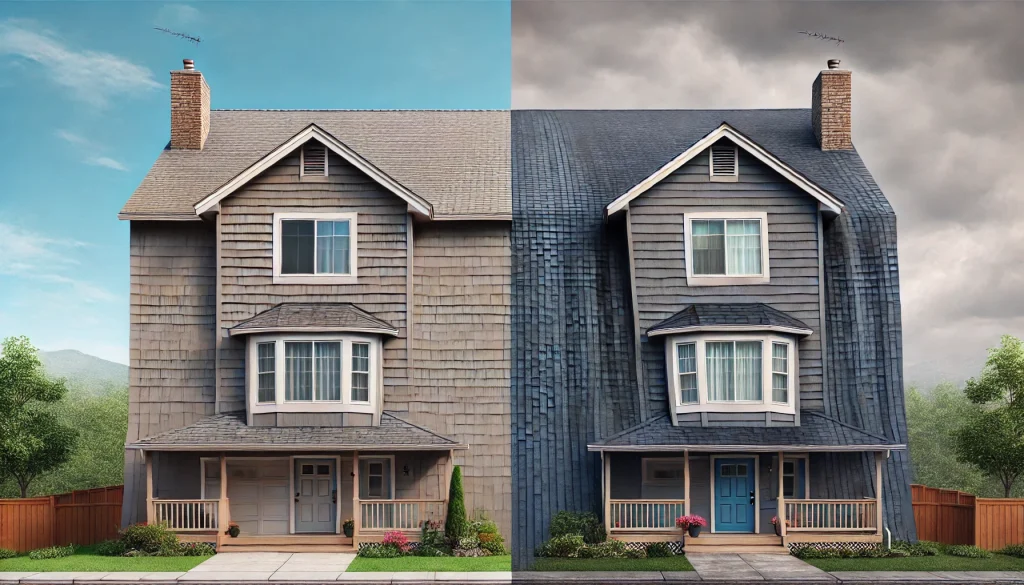Is your roof trying to tell you something? A well-maintained roof is crucial to protecting your home from the elements and avoiding costly repairs down the line. Discover the top signs that indicate it’s time for a repair or replacement.
Your roof is your home’s first line of defense against the elements. Over time, exposure to harsh weather conditions and natural wear and tear can compromise its integrity. Ignoring early warning signs of roof damage can lead to costly repairs and potential safety hazards.
This article will help you recognize the warning signs of roof damage so you can take action before it’s too late. By identifying these issues early, you can maintain the safety and value of your home while avoiding more significant problems down the road.
We’ll cover the five most common signs that your roof needs attention: missing or damaged shingles, water stains and leaks, sagging roof deck, granules in gutters, and the age of the roof. Understanding these indicators will empower you to take proactive steps in maintaining your roof’s health and ensuring your home remains a safe haven.
Roof looking rough?
If your roof is exhibiting any of these signs, contact Palm Life Restoration for a professional inspection. Our experts will assess its condition and provide honest recommendations to ensure your home remains protected.
Sign 1: Missing or Damaged Shingles
 Missing or damaged shingles are one of the most obvious signs that your roof may need repair or replacement. These issues can often be spotted from the ground. When inspecting your roof, look for areas where shingles are cracked, curling, or completely gone. Damaged shingles might appear discolored or have visible granule loss, giving them a different texture compared to intact shingles.
Missing or damaged shingles are one of the most obvious signs that your roof may need repair or replacement. These issues can often be spotted from the ground. When inspecting your roof, look for areas where shingles are cracked, curling, or completely gone. Damaged shingles might appear discolored or have visible granule loss, giving them a different texture compared to intact shingles.
Several factors can contribute to missing or damaged shingles. Severe weather conditions, such as strong winds, hail, and heavy rain, can dislodge or break shingles. Over time, the natural aging process can cause shingles to become brittle and prone to cracking. Additionally, poor installation practices can lead to shingles that are not properly secured, making them more susceptible to damage.
If missing or damaged shingles are left unrepaired, they can lead to serious problems for your home. The most immediate concern is water leaks. Without the protective barrier that shingles provide, water can seep into the underlying layers of your roof, causing rot and weakening the structure. This can result in significant water damage to your home’s interior, including ceilings, walls, and insulation. Over time, the structural integrity of your roof may be compromised, leading to more extensive and costly repairs.
Sign 2: Water Stains and Leaks
 Water stains and leaks are often the first visible signs that your roof may be compromised. These stains typically appear on your ceilings or walls and can be identified by discoloration, damp spots, or peeling paint. If you notice any unusual marks or dampness, it’s crucial to investigate further.
Water stains and leaks are often the first visible signs that your roof may be compromised. These stains typically appear on your ceilings or walls and can be identified by discoloration, damp spots, or peeling paint. If you notice any unusual marks or dampness, it’s crucial to investigate further.
Roof leaks can occur for several reasons. Common causes include damaged shingles, which allow water to seep through, issues with roof flashing around chimneys, vents, or skylights, and improper roof installation that leaves gaps for water to penetrate. Additionally, clogged gutters can cause water to back up under the shingles, leading to leaks.
Ignoring water stains and leaks can lead to significant problems. Water infiltration can cause mold growth, which poses health risks and can damage your home’s interior. Over time, persistent leaks can weaken structural components, leading to more extensive and costly repairs.
By recognizing these signs early and addressing them promptly, you can prevent further damage and maintain the integrity of your home. If you spot any water stains or suspect a leak, contact Palm Life Restoration for a thorough inspection and professional repair services.
Sign 3: Sagging Roof Deck
 A sagging roof deck is a serious sign that your roof is in need of immediate attention. You can spot this by looking at the roofline of your home; if it appears to dip or curve, this could indicate that the roof deck is sagging. Unlike other signs that may be purely cosmetic, a sagging roof deck points to structural issues that can compromise the integrity of your entire roof system.
A sagging roof deck is a serious sign that your roof is in need of immediate attention. You can spot this by looking at the roofline of your home; if it appears to dip or curve, this could indicate that the roof deck is sagging. Unlike other signs that may be purely cosmetic, a sagging roof deck points to structural issues that can compromise the integrity of your entire roof system.
Sagging in the roof deck can be caused by several factors. The most common cause is prolonged water damage, which weakens the wooden structure of the roof over time. This can happen if leaks are not addressed promptly, allowing moisture to seep into the roofing materials and wooden beams. Improper installation of the roof can also lead to sagging, as can excessive weight from heavy roofing materials or significant snow accumulation.
The consequences of ignoring a sagging roof deck can be severe. A sagging roof is at a heightened risk of collapsing, especially if subjected to additional weight or stress. This not only poses a danger to the occupants of the home but can also lead to extensive and costly damage to the property. Additionally, the structural compromise can allow more water to enter, exacerbating the damage and potentially leading to mold growth and interior water damage.
If you notice any signs of a sagging roof deck, it’s crucial to take action immediately. Contact Palm Life Restoration for a thorough inspection and professional advice on the best course of action to restore your roof’s integrity and ensure the safety of your home.
Sign 4: Granules in Your Gutters
 Granules are the tiny, sand-like particles that coat the surface of asphalt shingles. They play a crucial role in protecting your roof from the sun’s harmful UV rays and provide an additional layer of weather resistance. If you find granules accumulating in your gutters or downspouts, it’s a sign that your shingles are deteriorating.
Granules are the tiny, sand-like particles that coat the surface of asphalt shingles. They play a crucial role in protecting your roof from the sun’s harmful UV rays and provide an additional layer of weather resistance. If you find granules accumulating in your gutters or downspouts, it’s a sign that your shingles are deteriorating.
Granule loss can occur due to several reasons. One of the most common causes is the natural aging process of the shingles. Over time, as shingles are exposed to the elements, they begin to break down and shed granules. Severe weather events, such as heavy rains, hailstorms, or high winds, can also accelerate granule loss. Additionally, poor-quality shingles or improper installation can contribute to premature granule shedding.
The loss of granules is not just a cosmetic issue; it significantly impacts the performance and longevity of your roof. Without the protective layer of granules, shingles become more vulnerable to UV damage, which can cause them to become brittle and crack. This deterioration leads to a higher likelihood of leaks, water damage, and ultimately, the need for a complete roof replacement if not addressed promptly. Regularly checking your gutters for granules can help you catch this issue early and extend the life of your roof.
Sign 5: The Age of Your Roof
 The age of your roof is a significant factor in determining its condition. Most roofing materials have a defined lifespan, and once your roof approaches or exceeds this age, it becomes more vulnerable to damage. Knowing the typical lifespan of your roof material is crucial for proactive maintenance.
The age of your roof is a significant factor in determining its condition. Most roofing materials have a defined lifespan, and once your roof approaches or exceeds this age, it becomes more vulnerable to damage. Knowing the typical lifespan of your roof material is crucial for proactive maintenance.
| Roofing Material | Lifespan (Years) |
|---|---|
| Asphalt Shingles | 20-30 |
| Metal Roofing | 40-70 |
| Tile Roofing | 50-100 |
| Wood Shingles | 25-30 |
| Slate Roofing | 75-200 |
As roofs age, they exhibit certain telltale signs. Look for shingles that are brittle, cracked, or curled at the edges. The color of the shingles might also fade over time. Additionally, if your roof is covered in moss or algae, it might indicate that it’s nearing the end of its lifespan. These signs suggest that the protective qualities of the shingles are deteriorating, making your roof less effective at shielding your home from the elements.
An old roof is more susceptible to damage from weather conditions like wind, rain, and hail. As the materials degrade, the risk of leaks and structural issues increases. An aging roof can also negatively impact the energy efficiency of your home, leading to higher utility bills. Regular inspections and timely replacements are essential to prevent more severe and costly damage.
Roof looking rough?
If your roof is exhibiting any of these signs, contact Palm Life Restoration for a professional inspection. Our experts will assess its condition and provide honest recommendations to ensure your home remains protected.